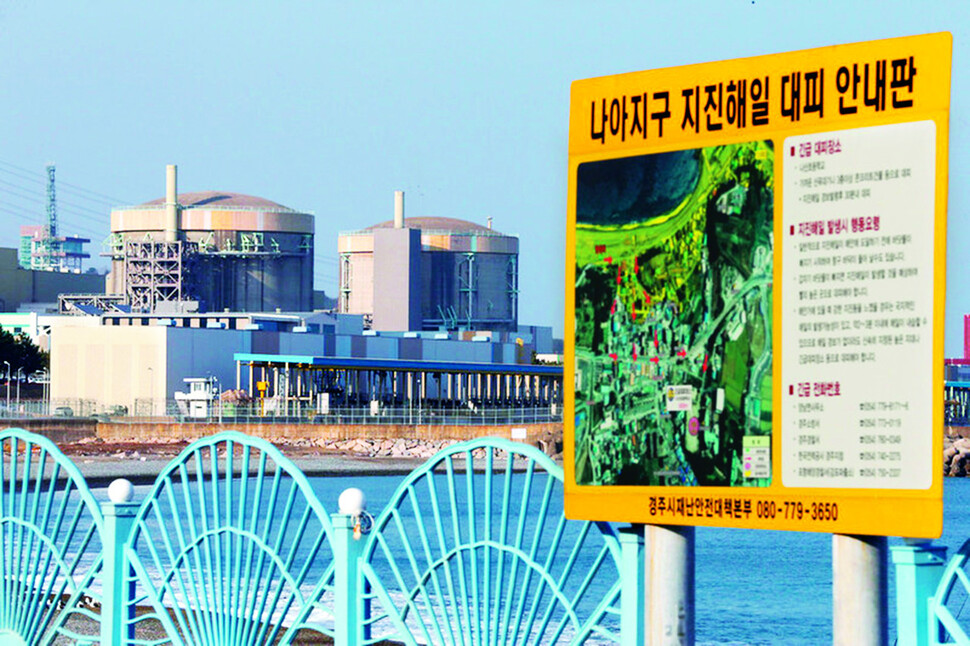Conservative media and opposition party “tritium even in anchovies”
Insisting that it is an exaggerated danger and the essence is blurred
No Nuclear Safety Act’Measurement Standards in Nuclear Power Plants’
“Private-public joint investigation to confirm the scope and cause of leakage”

Controversy is arising because tritium leaks into the basement of the Wolseong nuclear power plant in Gyeongju, North Gyeongsang Province. There is a tsunami evacuation sign on the beach in front of the Wolseong nuclear power plant. By Gyeongju/Lee Jeong-ah, staff reporter [email protected]
The radioactive leakage accident at the Wolseong nuclear power plant in Gyeongju, Gyeongsangbuk-do is moving away from the essence of’resident health’ amid the offensive of the cold nuclear camps opposing the nuclear power plant policy. Conservative media and conservative opposition parties disregard the fact that high concentrations of tritium were found in places that should not be leaked, and argue that’tritium exists in anchovies and bananas’. Local environmental groups, etc., demanded that the wasteful political battles be stopped and the extent and cause of the leak should be identified through a joint public-private investigation. In addition, the Democratic Party announced on the 12th that “we will closely examine the necessity of investigation at the level of the National Assembly,” regarding the detection of tritium, a radioactive material, in the groundwater of the Wolseong nuclear power plant site. Democratic Party leader Kim Tae-yeon said at the party’s in-house countermeasures meeting, “Tritium is a radioactive material that can cause genetic abnormalities by binding to living cells, and it cannot be taken lightly. The scale and cause of radioactive contamination of the aging Wolseong nuclear power plant, and whether it is poorly managed should be thoroughly investigated.” Party CEO Lee Nak-yeon also said the day before, “The fact that radioactive materials were detected in the groundwater of the Wolseong Nuclear Power Plant itself is shocking.” Accordingly, the power of the people responded face-to-face with the members of the relevant standing committee, saying, “We are ambushing some claims that are not scientific facts” in order to hinder the prosecution’s investigation into the early shutdown of the Wolseong nuclear power plant. They said, “The detected tritium was temporarily detected at a specific point in the nuclear power plant. It was not leaked to the outside and was recovered and disposed of. We must stop the low-level tricks of spreading tritium at the level of 6 bananas and 1g of anchovy as a ghost story.”
The end of last year <한겨레>, lately <문화방송>(MBC) and others reported one after another the contents of the report of’the management status and action plan of groundwater tritium in the Wolseong nuclear power plant site’ of Korea Hydro & Nuclear Power.did. In April 2019, 713,000 Bq (Becquerel) of tritium per liter was detected in the standing water in the manhole of the groundwater drainage system of the turbine building of Wolseong Nuclear Power Plant Unit 3. The detection point is a place where no radioactive material should be found, and the problem was that the detection concentration was also high, 17.8 times the emission standard (40,000 Bq/L) allowed for nuclear power plants. On the other hand, with the mouth of nuclear experts and KHNP officials, et al said that the risk was exaggerated by comparing the relatively high radioactivity concentration (measurement standard within the nuclear power plant) with the concentration allowed for external discharge. The conservative opposition’s objections were also based on this. But There is no’measurement standard in nuclear power plants’ anywhere in the nuclear safety related laws. This is because the nuclear power plant underground is not a regulated discharge route, and the continuous discharge of radioactive materials into the basement of a nuclear power plant should never happen. Since there is no standard value in the nuclear power plant, the emission standard is presented as a substitute reference value, but the fact is misleading as if there is a separate standard. Contaminated groundwater is likely to affect the outside of the nuclear power plant, but KHNP and regulatory authorities do not accurately determine the cause, size and impact of the leak. Residents around the Wolseong Nuclear Power Plant, who would be interested parties, suggested that instead of arguing, an investigation should begin. At a press conference on the 12th, the joint action for post-nuclear race citizens called for the formation of a public-private joint investigation committee in which residents, etc. participate, saying, “The situation can never be solved by KHNP’s good will.” They said, “I don’t know where and how much it leaks, where it flows through the groundwater, neither KHNP nor the Nuclear Safety Commission. A situation where nothing is known is putting us in more fear and danger.” The Federation of Environmental Movements also demanded that the day before, “a joint public-private survey should be conducted to accurately identify the cause of the problem.” By Kim Jeong-soo, senior reporter, Song Ho-jin, and Park Ki-yong, staff reporters [email protected]
